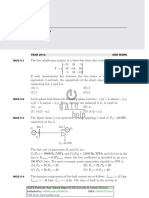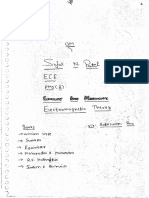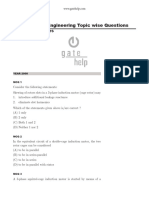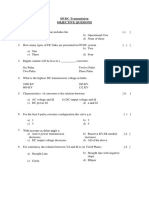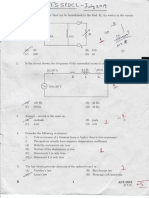0 ratings0% found this document useful (0 votes)
651 views32 pagesEE Control System Workbook
Uploaded by
Himanshu ChittuCopyright
© © All Rights Reserved
We take content rights seriously. If you suspect this is your content, claim it here.
Available Formats
Download as PDF or read online on Scribd
0 ratings0% found this document useful (0 votes)
651 views32 pagesEE Control System Workbook
Uploaded by
Himanshu ChittuCopyright
© © All Rights Reserved
We take content rights seriously. If you suspect this is your content, claim it here.
Available Formats
Download as PDF or read online on Scribd
You are on page 1/ 32
2021
workbook Electric Circuits + Control Systems
1. ntodcton to BR! Stems 56
2 Tne Response Ali = :
3 stability 6
4 ror Ae FAS | 6
5. Frequency erp RTO n
6 Controllers and Compensators 8
7 Stat Space Anais 2 |
|
2000
© Copyright Sujet rater to MADE!
Chapter-1 : Introduction
+ Introduction to control systems
* Closed loop and open loap systems
+ Problems
* Concept of transfer functions impulse response
and transfer functions and problems.
+ Transfer functions for mechanical systems,
+ Block diagrams and signal flow graphs.
Chapter-2 : Time Response Analysis
+ Introduction to time response analysis, standard
test signals, type and ofder of the system
+ Steady state response analysis:
+ Expression for error
+ Expression for error with disturbances
+ Steady state error for different types of
inputs and different types of systems,
+ Output compensation
+ Errorseries
+ Problems
ansient state analysis:
* Zero order system
+ First order system
* Second order syste
+ Higher order systems
+ Problems
Chapter-3 : Stability
+ Introduction to stability. Impuise response and
stability
* Routh-Hurwitz criteria
* Problems:
Chapter-4 : Root Locus Technique
* Root locus technique
+ Rules
= Root contours
= Inverse root locus
+ Problems
Chay
Chay
Control Systems
Description Sheet
pter-5 : Frequency Response Analysis
Introduction, frequency response analysis of
tem and spe
GM. and PM, concepts problems. G.M. and
PM
Polar plots problems.
Nyquist plots:
= Principle of argument
order 5 ications.
of second order systems (Derivations).
= Nyquist stability eriteria
+ Problems
Bode plots:
= Introduction and theory
= Problems
= Inverse bade piots
pter-6 : Controllers and compensators
P-controlier
[controller
D-controller
PIEPD aig PID Eontrollers
Lag compensator
Lead compensator
Lag-lead compensator
Chapter-7 : State Variable Methods and Analysis
State mode from differential equation and
transfer function
‘Transfer matrix
Stability from state models.
State equation solution
Controllability and observability.
State diagrams.
Introduction to Control Systems
Multiple Choice Questions
Q.1 (A) The closed loop gain when a feedback of
5 is introduced in the system shown,
AAs) = (5)
(@) 102 1% (b) 102 10%
(©) 100+ 10% — (d) 100.21%
(B) When there is a 10% change in the
feedback, the overall galnof the jsystem
would be
(a) 102 9% (b) 102.1%
(©) 100+ 9% (d) 100 = 1%
Q2_ Negative feedback in a closed-loop control
system DOES NOT
(a) reduce the
(b) reduce bandwidth
(c) improve disturbance rejection
(d) reduce sensitivity to parameter variation
[GATE-2015]
Q.3-_ (i) For 10% changein forward path the outputs
of open-loop system and closed-loop
system will get affected by
1 cus)
Fig.
waww.madeeasypublications.org
0 @—fo hr
Fig.)
(a) 10%and 1% — (b)
(©) 1% and 10% (di
(ii). For 10% change in feedback path then the
‘UIpUIS Of open-loop system and closed:
loop system shown above will be affected
by
(@)0%and.10% — (b) 0% and 1%
(c) 10% and 0%
}0% and 10%
1% and 1%
(d) 1% and 0%
‘The impulse response of the system is
Olt) =-te' + 26" (r>0)
The open loop TF will be
25+, 2s+1
(eae (ee
2s+1 (2s+1)
The impulse response of and LT! system under
initially relaxed condition is
nit) = et + 8
The response of the system for step input will be
(@ [+ete eur
(b) [et+ e24] u(t)
(© [1.8-et-05 2] u(t)
() [et +e*] u(t
Which among the following is a valid step
response of a initially relaxed system?
(@) 1-26'+e% (b) 1+2e'- 2%
(©) 1-26'-e% (d) 1+ 2e'+ oF
© Copyright
Q.7. The equivalentof the block diagram in the figure
a alles
@
() & “c
(©)
p—fne,
@ [Se
He,
[GATE-2004]
Q.8 Consider the following block dlagrams
1. Res, os)
Tet
Taye walang WEIS @
7pe9 oN WRG MAN UOHED|ARG ASV
To aaprop a >a aOR
3. “fie “9-H Go 2
a 8 nee eal” 2
mADE
© Copyright
Workbook
57
Which of these block diagrams can be reduced
transter 28. = —G_
totranster Fs) “7G,
(@) 1and3 + (b) 2anda
(©) tana (@) 2and3
(ESE-2001]
Find the transfer function a of the system
given below
as) vs)
Me)
4G
1+ HIG, + Ge)
oO;
Fleder
© FHG+@p
Q.10 By performing cascading and/or summing/
ditferencing operations using transfer function
biocks G,(s) and G,(s), one CANNOT realize
a transfer function of the form
@) G(s) Gs)
(bo) ea
© G0(qi5*4)
®) a ats -a13)
[GATE-2015]
EASY ee naney aircon
58
Q.11 The S.FG of certain C:S is shown in figure.
1 a= ax, + %
2. sg Ox, + 25%,
3. 242 ayn + Ar
Ae xG= 8414+ Ooty
Which of the following equations are correct?
(a) 1,2and3 (b) 1, 3and 4
(c) 2,.3and4 @ 1,2and4
0.12 The signal flow graph of a system is shown in
as)
the figure. The transfer function CIS) of y
he figure. The transfer functior RA) of the
system is
ryt 6 3
1
ew
© S216 =|) Binere
» 22) sleeer
© Zrmsr6 Frdas+6
[GATE-2003]
Q.13 An electrical system and its signal-tlow graph
representations are shown in the figure
(a) and (b) respectively. The values of G, and
H, respectively, are
vals)
vs)
Electrical Engineering Control Systems
°
Taped oN
apa) a Rw OA
3
MADE EASY
G his) G 1s) Gy
vis) X vas)
a
Figure)
Zs(s) Z3(s)
© ZO Zl} ZA Z)+ 2018)
(s) s)
(©) Z(8)=Za(s)+Zals) Z(8)+Zs(5)
FAG) Zs(8)
© ZA Zl) ZAO+ 219
1 a 2s(s)
De Z5()=Zals)+ 2.(65)' 208) 2315)
[GATE-2001]
Q.14 For the S.FG. the defined input is Als) and
defined output is C{s). Find the transfer function
Onn C ‘eu
os
(0) oH, =Fe ©) TH +A
¢. G
© TH, @
Q.15 The signal flow graph of a system is shown
bbelowe(s) 5 the input and C{s) is the output
‘Assuming, h, = b, and hy = b,— b,a,, the input-
as)
output vaste tuncton, @) = 2) of ho
system is given by
@ Gis)=— 2st
Pasa,
(b) G(s) = 2842
Fe bs+ By
bs+by
G(s) = —PS+
© G0) Fy asta °
ays+ay
(6) Gis) = +
@ 60) 3S
Q.16 For the signal flow graph shown in the figure, | =
‘ue of 2) H
the value of Fa) is
CG PGtOGGOH HY,
06.6,6,
(0) CGH AEGH, CGR CBEA HH,
(0) GGA, CGH, CGH HOG:
aH
(8) GGA CGH, CE +COSG.HMe
(GATE-2015]
Numerical Data Type
Questions
Q.17 The open-loop DC gain of @ unity negative’
feedback system with closed-loop transfer
> peareddey oa feu ya0a sO DE
+4
function =
475413
[GATE-2001]
Q.18 For the signal flow graph shown below,
4
o~
Sy
R .
7
The overall gain C/R will be
© Copyright MADE
Workbook
59
Try Yourself
TA. The block diagramaf a system is shown in the
figure.
ROG i}
L_
Ifthe desired tra
Co)
fer function of the system is
Cls)__ 8
Ris) P4842
then G(s) is
@1
(b) s
1
©
[Ans: (b)]
72. Thetransfer function ofthe network shown below
=i
me
[mm |
The transfer function of a low-pass RCnetwork
1
T? 43s +1
13
. 1
(@) ROS(1+ ACS) (0) GAS)
oS
(9) (RCS)
(Ans: (b)]
AC
(©) (RCS)
ERsY “wwwumadeeosypublications. org
Time Response Analysis
|2]@4 Consider the unity feedback system as shown
below. The sensitivity of the steady state error
to change in parameter K and parameter a with
ramp inputs are re:
[YJ muttipie choice Questions
Q.1_ For the given system, how can be steady state
error produced by step disturbance be reduced?
Ris) a 1
@ ye 7
Djs) = disturbances
As) ;
-O—-[ai (ae —
; ml & @1.4 (14
(©) 1.0 (a) 0.1
ie [ESE-2003]
(a) By increasing de gainal G(s)G.(s) 5
(b) By increasing de gain of G.(s) Z Q.5 The steady state error when the torque (7,)
(0) By increasing de gain of G(s) : changes at a rate of 2 N-m/see, will be _
(€) Byremoving the feedback : TAs)
[ESE-2008) | = rae z as} a0
Q2_ A ramp input applied to ap unity feedback
system results in 5% steady state-error. The
type number and zerd frequency gain of the} 3 (a)n0:Sunits (b) 0.78 unite
system are respectively (©) 1 unit (9) 1.25 units
(@) 1and20 (b) Oand20 2
7 , Q6 The unit of a unity feedback
(©) Gand 55 (d) tand 35 a system with open loop transfer function
G(s) = Ki((s + 1) (s + 2)) is shown in the figure.
[GATE-2005) The value of K is,
Q3_ A particular control system yielded a steady-
tate error of 0.20 for unit step input. A unit | =
Integrator is cascaded to this system and unit
ramp input is applied to this modified system
What is the value of steady-state error for this
modified system?
(@) 0.10, (b) 0.15
(©) 020 (9) 025 ie () 2
4 ) 6
[ESE-2006]
woww.madeeasypublications.org MADE EASY © Copyright
MADE ERSY
7 The transfer function of @ system is
100
Gl2)- Sea(s+100)
the system the approximate settling time for 2%
criterionis
(a) 100sec
(c) 1sec
For a unit-step input to
(b) 4sec
(d) 001sec
[GATE-2002]
A linear network has the system function
(s+o)
(+ ays+b)
The outputs of the network with zero initial
Conditions for two different inputs are tabled as
su ealang WOuhOD @
as
input)
ua
eo uth
‘Then the values of cand Hare, respectively
(@) 2and3 () Band 2
(©) 2and2 (@) tand3
[ESE-2005}
The block diagram of a unity feedback control
system is shown below:
ag
oo) EHS ats)
= re
Determine the time at which first undershot
occurs.
(@) 0.78sec (b) 2.69 sec
(©) 3.14 sec (d) 1.56 sec
ju pain 0 HOBTERIBA 2a FRU HOOG SIU |O ed On ued AON RVONBDTARA ASva SaVWO
Q.10 A system described by the folowing differential
ay 3%
tion T¥ 43% 4 ay = x(t) is initial
equation Sy +336 +2y= a(t) is inital at
rest. For input x(0) = 2e(f), the output 40) is
(a) (1-20'+ 2)
(b) (1.4 2e'- 207) 41)
(6) 5 4e%4 15%) up
(@) (05 +20"+ 26% 41) 7
[GATE-2004] | =
Q.11 A second order control system is defined by | >
the following differential equation
mADE
Workbook 61
act)
+850 4 160(t)= 1640)
The damping ratio and natural frequency for this
system are respectively
(a) 0.25 and 2 radis
(b) 0.50 and 2 rad/s
(©) 0.25 and 4 rads
(d) 0.50 and 4 rad/s
[ESE-2001)
Q.12 A position control system having wtb. has
| 10K
O8)= 550.15)
(The minimum value of ampitier gain “K’ so
that when the input shaft rotates at 1/2 rps
the steady state ertor is equal 0 02° will be
(@) K=60 (b) K=70
(o) K=80 (@) k=
With above value of °K’ the damping ratio
nd natural frequency of oscillations are
i)
(a) 9=0.05 (©) 9=0.05
= 5 118 oo) = 85118
02. (o) 9=0.02
rls n= 85118
Q.13 The unitstep response of a second order system
is=1-e%'-5te™
Consider the following statements:
4 TR Gidathpd natural frequency is 5 rads,
2. The GaMping ratio is 1
SreThelimpulse response is 25te*
Which ofthe statements given above are coect?
(@) Only1and2 — (b) Only2and3
(©) Only1and3 (a) 1,2and3
[ESE-2006]
Q.14 Atransducer has 2 poles as shown isthe figure.
The steady state output of transducer for unit
step input will be
ERSY wwnw.madeeasypublications.org,
62 Electrical Engineering @ Control Systems
1
@4 ) JB Ay
© ve (0 3
Q.18 The position control of a DC servo-motor is
given in the figure. The values ofthe parameters
are K,= 1 Nm A, R,= 10, L,= 01H
5 kg-m?, B = 1 N-m (radisec) and
Vi(radisec). The steady-state position
response (in radians) due to unit impulse
disturbance torque T, is
vas), 9
(@ 05
4
me
TEE)
{b) -0.5
(d) -1
Q.16 The characteristic equation of a contéol system
is 9{s%+ 6s + 13) + k=O. The value of k’ such
that the characteristic equation has a pair of
[GATE-2015]
"0" Ge oft heed
The ll order approximation using dominant pole
concept is
complex roots with real part ~1 will be E
(@) 10 (b) 20 g
(c) 3 (d) 40 .
Q.17 The transfer function of acontrol systemis |=
40. 2
©) 3
erauer |
10 10 3
© Byer 8 EH By
Q.18 A control system has @s)=—!2_ ana |Z
ae+5)
H(s) = K. What is the value of for which the
steady-state error for unit-step input is less than
5%? :
(@) 0913 (©) 0927 :
(©) 0.953 (@) 1.050 3
[€SE-2017] |
MADE EASY
Numerical Data Type
Q.19 The steady state error is _ for an input of
r(t) = 2 + 3t + 4f? for the given system
Ld
Q.20 The open loap transfer function of a unity
feedback control system is given by
es)
Qs)
K
Ase. | gain kis increased to infinity
then damping ratio will tend to become
[ESE-2005]
Q.21 The closed-loop transter function of a system is
T=
= exoaeray’ Te steady state eror
due to unit step input is ___
[GATE-2014)
Q.22 The unit step response of a system having
Wansferfuriction H(s) - a is shown in figure
s+
cee
The value of *k’ and ‘A’ are and
Q.23 In the feedback system shown below,
99) = Fy a5
The step response of the closed-loop system
should have minimum settling time and have
no overshoot.
© Copyright
~ |
The required value of gain kto achieve thisis__.
[GATE-2016]
Q.24 The open-loop transfer function of a de motor is
10
1410s
ks)
Vis)
given as When connected in
feedback as shown below, the approximate value
of, that wil reduce the time constantof the closed
loop system by one hundred times as compared
to thal of the open-loop systems
Re), vats)
70] ots)
T3105
[GATE-2013]
T1, A unity feedback system has the open-loop
tantric =
Determine the values of K afieljp|S6 thatthe
settling time and peak overshoot will be
4 seconds and 10% respectively: Take #2% of
the steady-state value definition for settling time.
[Ans: p = 2, K = 2.85]
(econo MADE EASY
“anaatang WEd05 @
30
PES ON 1ueG MBN aUBTEBIGRa ASy:
Ba 2 Few yooa sh
12,
13.
14,
Workbook 63
A control system is defined by the following
mathematical relationship
x , dx
+6245 an
Geet 1(1-e2)
‘The response x(t) ef the system as ¢ = is
[Ans: 2.4]
The unit step response of a system is given
below,
= 140.261.2610
The damping ratio (&) of the system is
[Ans: 1.43]
Transfer function of a control system is
14.45
(SF #1,2045+2.829)5+5)
‘The"peak time for the unit step response is
sec.
Ts) =
[Ans: 2]
wwwmadeeasypublications.org
Multiple Choice Questions
21. Naten he folowing
' =
aes 1a
' a
xX + ty
© 2+—“4.,
xXo4 '
& Lia
@o—* & pA,
k |
'
ope + ARG
x
> a
x |
AS Goes
@s 4123
os oe
@1 2 3
O34 215
@.2 Thenumber ooo inet hand sie of s plane
or the system whose characteristic equation i
+ 8s" + 18s? + 165+5=0
1
(4 (ESE-2006)
ver madeessypubicationsorg
a
z
AR EGON
as
as
as
MADE ERSY
Th
is given by
+28" + 8s" + 1259+ 20s?+ 165 + 16 =
The number of the roots of the equation which
\i@ on the imaginary axis of s-plane is
(a) zero (o) 2
© 4 @ 6
rac
istic equation of a control system
[ESE-2003]
‘Tne characteristic polynomial of a system is
AS) = 29 +5 + 45° + 2% + 2541
he system is
(a), stable (b) marginally stable
(c) unstable (A) oscillatory
[GATE-2004]
The system having characteristic equation
st + 253+ 35° +25+k=0
is lobe used as an ascillator
Ook andi fre quenc
fa)
(o) k
(©) k=2and@=
What are the values
cillation w?
(d) k=2and@=2 ris [ESE-2006]
Thefeed cl sy
lem inthe figureis stable,
o ° tele
fs
~cs)
(b) only is K>0
(d) only f0SK<
[GATE-2001]
(@) forall K20
(©) onlyifosK Kp
[GATE-2016]
10 The open foop transfer function of a unity | =
feedback control system is given by a
K(s+1) 3
~ te K>ar> i
OS) = Sa Ts) (1428) lies >
The closed loop system will be stable if, ;
ake) :
(a) O03 (b) K< 0.05
() 0050
[ESE-2017]
Numerical Data Type
Questions
Q.12 Consider the unity feedback system with
=
(s? 428+ 2)(s+2)
The system is marginally stable
fad/sec frequency of oscillation?
{ESE-2008]
As) =
isthe
Q,13 For the polynomial
Pls) = 89+ 544 269425? + 35415, are
number of roots whieh lie in the right haf of the
splane
[GATE-2004]
Q.14 The characteristic equation of an LT! systems
given by:
F(s) = s° + 2s! + 3s? + 6s? - 4s - 8 = 0
‘The number of roots that lie strictly in the left
half s-plane is ___.
[GATE-2015]
Try Yourself
1. A-single-input single-output feedback system
has forward transfer function G(s) and feedback
transfer function H(s). It is given that
1s) H(s)1 < 1. Which of the following is true
about the stability of the system?
(a) The system is always stable.
(b) The system is stable if all zeros of Gis) H(s)
are in left half of the s-plane.
wwwmadeeasypublications.org |
66
(c) The system is stable if all poles of G(s) H(s)
are in left af of the s-plane.
(d) Itis not possible to say whether or not the
system is stable from the information given,
[Ans: (d)]
T2. With negative feedback, the system stability
and system gain respectively
(@) Increases and increases
(©) Increases and decreases
(©) Decreases and increases
(@) Decreases anddecreases Ans: (b)]
The correct sequence of steps needed to
improve system stability is
(a) Insert derivation action, Use negative
feedback and Reduce gain
(©) Reduce gain, Use negative feedback and
Insert derivation action.
(6) Reduce gain, Insert derivation action and
Use negative feedback
(A) Use negative feedback, Reduce gainiand
Insert derivation action
13,
(Ans: (4)]
In the feedback system shown in figure
_
© St) (14 Sta) Sto),
14,
GIs)
Electrical Engineering Control Systems
ka
(oe aa
15.
ay
Towed wa
Using the Hurwitz-Routh method, determine the
necessary conditions for the system tobe stable,
»+0O-
is)
ans: 0< K< 2) 4,>0andt,>0
t
and this is the only possible case.)
Consider the feedback system shown below:
ra
za
Ifthe poles location for this system is as shown
in figure below, then the value of Kis
| jo
Root Locus Technique
Multiple Choice Questions
Q.1 Consider the points s, =-3 + j4ands=-3=J2
inthe s-plane. Then, fora system withthe open-
loop tranater function
GIs\Hs)
ey
(@) 5, is on the root locus, but not s,
(©) s,is on the root locus, but not s,
«)
@)
both s, and s, are on the root locus,
neither s, nor s, is on the foot I
[GATE-1999]
Q2. Theeh
is given by
as +4) (s° +2548) +Hs+1)=0
What are the angles of the asyraptoles far The.
ristic equation of a control system
root loci for k= 0?
(a) 60°, 180°, 300° (b) 0%) 480") 800"
(©) 120°, 180°, 240° (d) 0°, 120°, 240
[ESE-2005)
Q.3. Thecharacteristic equation of a feedback control
system is given by s? + 5s*+ (K+ 6)s+K=0.
In the root loci diagram, the asymptotes of the
root loci meet ata point in the s-plane whose
coordinates are
@ (2.0)
(c) (2,0)
(©) (1,0)
(d) (3,0) [ESE-1999]
Q.4. The root locus plot of the system having the
loop transfer function
ss
sis+4) (6? +4s+6)
Gis) Ms) =
© Copyright
MADE EASY
no breaka
three real breakaway points
only one breakaway point
plex breakaway points
[ESE-2001]
fay point
one real and two co
nich of the followings the following is the valid
root loci
= Kista es ta
+b)
als)
(a)
i)
Q.6 An unity feedback system is given as,
K(-s)
s(s+3)
Indicate the correct root locus diagram
G(s)=
‘wwwmadeeasypublications.org |
Electrical Engineering
68
jot
we
wy
@
[GATE-2005, IES-2001]
Q7 The OL.TFota system is G(s) =“
sis+a)
The valid root locus for 0 < a < « when K = 10
(a) aan ee
(©)
Control Systems
oT)
jaenedid aa feu wooa sn
as
MADE EASY
© “ro
\
©)
w,
The root-locus diagram for a closed-loop
feedback system is shown in the figure, The
system is overdamped
only ifO0 5
i05
(a
(o)
(0)
«)
[GATE-2001]
@.9- ThE rootlloeus of a unity feedback system is
shown in the figure,
(@)
(b)
As)
Giperg+K — [GATE-2014)
‘©Copyright
Q.10 The OLIF of a control system is
Kis+4/3)
“SF s+12)
The valid AL will be
|,
Gs)
(a)
\
\
(o) }
©
(a)
Numerical Data Type
‘Ques'
Q.11 A unity feedback control system has an open-
loop transfer funetion
_ K
© s(s° +7s+12)
is gain K for which s = —1 + /1 willie on
the root locus of this system
ais)
[GATE-2007]
© Copyright
ory
ha ASv3 JV
MADE EASY
Workbook
69
Q.12 The characteristic equation of a unity negative
feedback system is 1+ KG(s) = 0, The open
loop transfer function G(s) has one pole at 0
and two poles at~1. The root locus of the system
for varying Kis shown in the figure.
jo
The constant damping ratio line, for &
intersects the rootlocus at point A. The distance
from the origin to point A is given as 0.5. The
Value of Kat point A is
[GATE-2014]
Q.13 The open-loop transfer function of a unity
feedback configuration is given as,
Kis +4)
(s#8)(s" -9)
The value of a.gain.A(> 0) for which 1+ 2 lies
on the
As)
at locus is
‘[GATE-2015]
Try Yourself
TI. Considera feedback system with characteristic
equation
t+.
SIs+ 0(5+2)
Compute the angles of the asymptotes of the
root-locus branches with the real axis of the
s-plane.
wwvwanadeeasypublications.org
70
Also find the centroid and the breakaway points,
of the root-locus of the system. Assume that
varies from 0 to =,
[Ans. Centroid > (-1, 0)
Breakaway point s = -0.422]
2, Draw the root loci of the system showing all the
relevant point for open-loop transfer function of
the system given by
kK
As) _
ss? +48+8)
13. Given Gis) Ms)
(i) Determine the value of K for which the:
[Ans: K = 20]
(ii) For the damping ratio (8) 0.34, determine
Electrical Engineering ® Control Systems
SCT)
Tegan suoneoNana ASV:
14,
15.
The forward-path transfer function of a utb
system is
K(s+2)
(s43)(s° +2842)
‘The angle ofieparture from the complex poles.
is +6, where 9, = __degree.
[Ans: 108.4]
as) =
‘The forward path transfer function of a unity
negative feedback system is given by
Gs)
GQ6-9
The waiue of Kwhich will place both the poles
ofthe closed-loop system at the same location,
is
[Ans: K = 2.25]
© copyight |
Frequency Response Analysis
QA For x =sin Find Y(0. z
3
xo—] sy ew
s 1 els
(@) VBsint +45") ()| gpsinit-45) |B
5 1 L
o) V2sin(t—45*) (0) sesin(t+ 45°) le
(©) VBsint-4 eons) whe
Q2 Aut. system has forward path transfer |
function £
10 g
as)- 18 i
The resonant
+10)
requency Bad BW
respectively
(a) 7.07 ris, 12.7
(o) 12.
1s, 7.70 is
(©) 7.7018, 1.27 ris
(d) 1.27 Ws, 7.07 tls
a3
When
and
The value
The transfer function of a system is,
Qs)__S
Als) S+P
r() = Psin(2t—9
tn = sin(at
of P' will be
)
60")
(oy
(1
a8
as
The phase margin (in degrees) of a system
having the loop transfer function
o 23
GisH{3)\= 2 is
s+ 9)
(a) 45° (b) -90
(©) & (a) 9° [GATE-1999]
The system with the open loop transfer function
1
G(s)H(s) -—— as a gain margi
) hte ea
(a) 608 8
(c) 3568 e
[GATE-2002]
‘A second order system has
[GATE-2007}
The OLTF of
unity feedback system is
ast!
Gis) =
The value of ato give phase margin = 45° willbe
@ 2 (©)
a Bi
® Tp
Jue TESE-2004)
The polar plot (for positive frequen nthe
open-loop transfer function of a unity feedback
control system is shown in the given figure.
wwwsmadeeasypublications.org
72
Im Gyo)
The phase margin and the gain margin of the
system are respectively
(a) 160° and 4 (b) 150° and 3/4
(©) 30°and4 (9) 30° and 3/4
[ESE-2000]
Q9 The open-loop transfer function ©
en as
a unity
feedback control systemis gi
=
~ stitsh)(t+ 572)
is)
The phase crossover frequency and the gain.
margin are, respectively
@ pea
Vii ng
FR ana tle
[Fz and ATR
() VN =
i) and 5
(d)
[ESE-2001]
Q.10 The pha:
margin (PM) and the damping ratio.
& )are related by
|.
«9 |
www.madeeasypublications.org
Electrical Engineering © Control Systems
Trew voa
MADE EASY
MADE EASY
(a) PM= 180° -tan
[ESE-2003]
List-1 and List-II show the transfer function and
polar coh List-1 with List-I1
wer
s respectively, M
and select the correct an:
List!
- ‘1+ST)
8 ——
(r+si,)(sT,)
— |
C. S(trst,)(s7.)
—
D. (1+ sheets)
Listll
\
7
2
3.
4
© Copyright
Codes:
A
(@ 2
&) 3
2
@3
=s40
nened
[ESE-2002]
Consider the Nyquist diagram for given KG(s)
H(s). The transfer function KG(s) H(s) has no
poles and zeros in the right half of s-plane. If
the (-1, 0) point is located first in region I and.
then in region I, the change in stability of the
system will be from
12
(@) unstabe to stable
(b) stable to stable
(c) unstable to unstable
(d) stable to unstable
[ESE-2002]
.13 The Nycuist plot ofa unly feedbuek sysiony
having open loop transier--function
(s+3)(s+5)
6) = MS BUS#D) Joy = 1 is a8 show
a) = MESS) fork = 118 8 shown
‘below. For the system to be stable, the range of
values of Kis
Img 4 GH plane
(@) 01.33
(b) O 1.33
[ESE-2003)
‘© Copyright
2
i
3a fe 908 ST
Workbook
73
Q.14 Aunity feedback control system has a forward
et
loop transfer function as —
Its phi
eee eal
value willbe zero at frequency «,, Which one of
the following equations should be satisfied
byo,?
(@) @,=cot(To,) (0) @, =tan(To,)
(©) Ta, =cot(@,) (A) Tw, =tan(o,)
[ESE-2004)
Q.16 The polar diagram of a conditionally stable
system for open loop gain K= 1 is shown in the
figure: The open loop transfer function of the
systemis known fo be stable. The closed loop
system is stable for
Im
\Z
ase ——
esa
KeSortcket
@ K [GATE-2013] |)
s s a =
Q.18 The polar plot of the open loop transfer function | = 23 tous
10(s+ 2
fo < = will be i
as) = ME foros be in the |5
(@) first quadrant (b) second quadrant. | >
(©) thitd quadrant (qd) fourth quadrant a oi
(GATE-2015] | 7 @ ——S__
i (1+ 0.5s)(1+ 0.25)
Q.19 The number and direction of encirclements
by the Nyquist plot of Gls) = 7 is o
7s (1+ 23)(1+ 48)
(a) zero. (©) one, anti-clockwise.
(©) one, clockwise. (2) two, clockwise. —— [EE: GATE-2016]
[GATE-2016] (1 2s)(1+ 4s)
oe .3 MADE ERSY
‘© Copyright
Q.22 Loop transfer function of a feedback systemis
+3
~. Take the Nyquist contour
GSH8)= Fig—3)
in the clockwise direction. Then, the Nyquist plot
of G(s)H(s) encircles ~1 + jO
(a) once in clockwise direction
(©) twice in clockwise direction
(c) ance in anticlockwise direction 3
(@) twice in anticlockwise direction
Q.23 A unity feedback control system is
characterized by the open-loop transfer function
10K (542)
Gs)= =
5) +3s7410
The Nyquist path and the corresponding Nyquist
plot of G(s) are shown in the figures below.
a»
seat
Shr oo gaNSUBNROHARs 1Sv 500
a 4
3
=e =
Nyquist path fr Gis) e
yim
is) lane
15434
—~
—_{Ca-
0
543
Nyquist plot fr Gis)
110 < K< 1, then the number of poles of the
closed-loop transfer function that lie in the right
half of the s-plane is,
© Copyright
MADE EASY
Workbook 75
(a) 0 (1
(2 (3
[GATE-2017}
Q.24 The approximate Bode magnitude plot of a
minimum-phase system is shown in the figure.
The transfer function of the system is
wl
140
7) 100
@) 10° =
(s+10) (+100)
5 +04
©) 10" (s+10)(¢+ 100)
2
ee _
(s+ 10) ($+100)
[GATE-2003]
Numerical Data Type
Questions
Q.25 ___radisecis frequency at which the steady
state sinusoidal response becomes zero.
(s° +9)(9+2)
(e+ (s+4)(5+5)
as
26 is the value of damping ratio when
resonant peak is unity?
Q.27 The phase margin in degrees of
10
O8)= SO S+ EID)
calculated using the asymptotic Bode plot is
[GATE-2014]
wwwmadeeasypublications.org
76
Q.28 The Bode asymptotic magnitude plot of a
minimum phase system is shown in the figure.
2602
Gye
(a5) 602
| ‘efrads) in fog scale
If the system is connected in a unity negative
feedback configuration, the steady state error of
the closed loop system, toa unit rampinput,is__
[GATE-2014]
Q.29 The transfer function ofa mass-spring-damper
system is given by
Electrical Engineering © Control Systems
MADE EASY
Q.31 The phase margin (in degrees) of the system
having open loop transfer function
10
Sc10) 5 ae
- [GATE-2015]
Q.32 Determine the open loop transter function, Gls) Hs),
of a feedback control system whose Bode-Piot’s
magnitude characteristic is shown in the figure.
Lo He 4
ao. of 10 8a aan
uae [ESE-2008}
The frequency response data for the system
ate given in the following table z}as3 +
canes] Tegal nas | watotemees ap} |
oot 188 02 2 |
oa “5 aa z |
02 “ea 6 ei
te Sia 2
2 =a ~s24 Z
3] os Een Dae
a) a 4 Find te transfer function?
wo [83 ars 10.34 A minimum phase function has 3 finite poles
The unit step response of the system
approaches a steady state value of __.
[GATE-2015]
Q.30 Consider the Bode plot shown in figure. Assume
that all the poles and zeros are real valued.
Freq, (He)
The value of f,
f, (in Hz) is
[GATE-2015)
‘www.madeeasypublications.org
and 1 finite zeroes. Its phase angle as @ = =
will be ~kx m2 rad
Then the value of k is
Q.35 In the feedback system shown below
1
aire CErCrC)
OS =
i Ld
The positive value of kor which the gain margin
of the loop is exactly 0 dB and the phase margin
of the loop is exactly zero degree is _.
[GATE-2016)
© Copyright
MADE ERSY
Q.36 The asymptotic Bode phase plot of
ais)
k
Gro H+ OS+H)'
with k and p, both positive, is shown below.
The value of p, is
[GATE-2016]
Q.37 The input i(t) = 2 sin (3t # mis applied to a
system whose transler function
G(s) = —* the amplitude of he outputot
earoF Meamoltudeotthe ouput
the system is
TIN: GATE-2016]
Try Yourself
T1. The Blode magnitude plotofthe transfer function
K(t+0.58) (1+ a5
ats) = A 08) 28
(1+ S)a+b9 [1+ 8)
is shown below.
Note that -6 dB/octav
value of albK is,
oor
-20 dB/decade. The
6 68/0ctave
o.sa/0cave
You might also like
- SSC JEn 2013 Electrical Paper SolutionsNo ratings yetSSC JEn 2013 Electrical Paper Solutions31 pages
- Power System Analysis - EE3501 - Hand Written Notes - Unit 3 - Symmetrical Fault AnalysisNo ratings yetPower System Analysis - EE3501 - Hand Written Notes - Unit 3 - Symmetrical Fault Analysis32 pages
- Final Paper EEE TG GENCO AE 2024 EXAM PAPER SOLUTIONS 14 07 2024No ratings yetFinal Paper EEE TG GENCO AE 2024 EXAM PAPER SOLUTIONS 14 07 202445 pages
- Control System by Sujal Sir (9574234622) For Gate100% (1)Control System by Sujal Sir (9574234622) For Gate268 pages
- Electrical Machine Paramount (EE) + FrontNo ratings yetElectrical Machine Paramount (EE) + Front81 pages
- Electrical Engineering (EE) - GATE Books - GATE 2016 PDF75% (4)Electrical Engineering (EE) - GATE Books - GATE 2016 PDF5 pages
- SSC Je Electrical 24 03 2021 Shift 1 61No ratings yetSSC Je Electrical 24 03 2021 Shift 1 6111 pages
- ESE - (Paper-II) - Electrical Engineering - FINALNo ratings yetESE - (Paper-II) - Electrical Engineering - FINAL33 pages
- Made Easy: Lockdown Period Open Practice Test Series100% (1)Made Easy: Lockdown Period Open Practice Test Series19 pages
- EMT Hand Written Theory Note of ACE ACADEMYNo ratings yetEMT Hand Written Theory Note of ACE ACADEMY356 pages
- Lecture 4: Small-Signal Diode Model and Its ApplicationNo ratings yetLecture 4: Small-Signal Diode Model and Its Application9 pages
- Power System Notes by Ankit Goyal BbbbbbyNo ratings yetPower System Notes by Ankit Goyal Bbbbbby85 pages
- Electrical Machines: IES Electrical Engineering Topic Wise QuestionsNo ratings yetElectrical Machines: IES Electrical Engineering Topic Wise Questions78 pages
- Post: Jr. Engineer (Electrical) : Question BookletNo ratings yetPost: Jr. Engineer (Electrical) : Question Booklet16 pages























